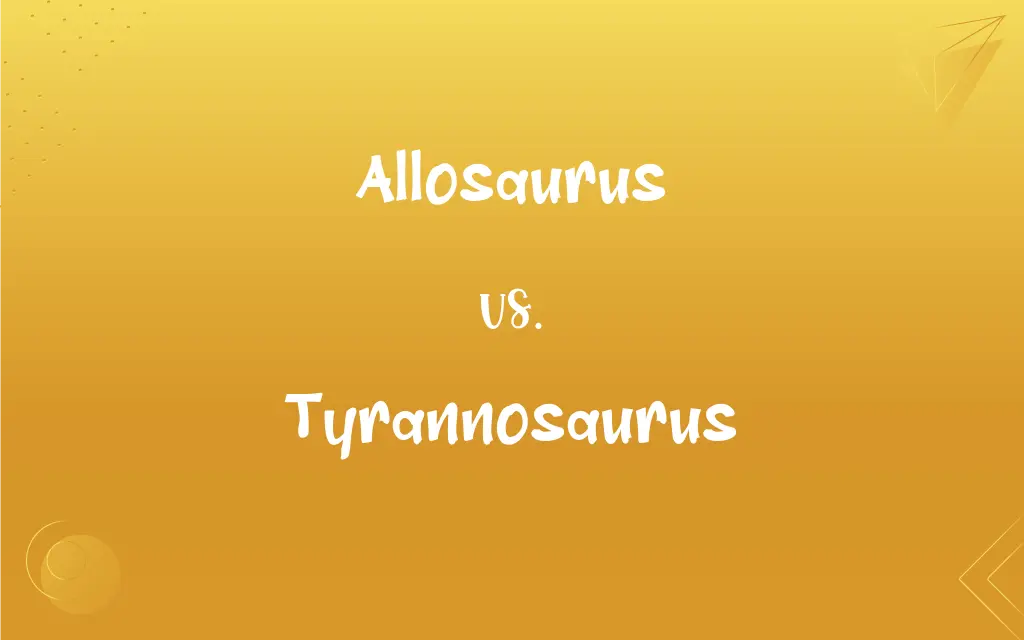Allosaurus vs. Tyrannosaurus: What's the Difference?
Edited by Aimie Carlson || By Janet White || Published on October 17, 2023
Allosaurus and Tyrannosaurus were large theropod dinosaurs, but the Allosaurus lived during the Jurassic period and was smaller, while the Tyrannosaurus lived during the Cretaceous period and was notably larger.

Key Differences
The Allosaurus is a dinosaur that walked the Earth approximately 150 million years ago during the late Jurassic period. On the other hand, the Tyrannosaurus, frequently dubbed T. rex, roamed about 68 to 66 million years ago during the late Cretaceous period. Thus, these two predatory dinosaurs did not encounter each other as they belonged to distinct epochs and environments in the prehistoric era.
In terms of physical characteristics, the Allosaurus was smaller than the Tyrannosaurus, typically measuring around 28 feet in length. Conversely, the Tyrannosaurus was one of the largest carnivorous dinosaurs, with some specimens measuring up to 40 feet in length, underlining a significant difference in their physical statures and potential prey.
Their physical structures also exhibit divergences, notably in their cranial and dental anatomy. The Allosaurus had a larger, more elongated skull with comparably smaller teeth, while the Tyrannosaurus had an extraordinarily robust skull equipped with large, banana-shaped teeth, reflecting distinctions in their hunting and feeding strategies.
The Allosaurus possessed relatively long, robust arms equipped with three-fingered hands which could possibly grasp prey. The Tyrannosaurus, known for its disproportionately tiny arms, had only two functional fingers, which presumably played a minimal role in prey capture and feeding, indicating a clear divergence in their predatory behaviors.
Fossilized remains of Allosaurus are predominantly found in the Morrison Formation, spreading through the present-day western United States. Tyrannosaurus fossils are largely located in North American rock formations. These geographical discrepancies highlight the varying ecosystems and prey availability that each species had to adapt to, shaping their respective evolutionary paths.
ADVERTISEMENT
Comparison Chart
Time Period
Lived during the late Jurassic period (about 150 million years ago).
Lived during the late Cretaceous period (about 68 to 66 million years ago).
Size
Generally smaller, measuring up to 28 feet in length.
Notably larger, some specimens measured up to 40 feet.
Skull & Teeth
Larger, elongated skull with smaller teeth.
Robust skull with large, banana-shaped teeth.
Arms
Longer arms with three-fingered hands.
Very short arms with two functional fingers.
Fossil Location
Primarily found in the Morrison Formation in the western United States.
Mostly found in North American rock formations.
ADVERTISEMENT
Allosaurus and Tyrannosaurus Definitions
Allosaurus
A large carnivorous dinosaur that lived during the late Jurassic period.
The Allosaurus was one of the apex predators during its time.
Tyrannosaurus
A gigantic carnivorous dinosaur residing in the late Cretaceous period.
The Tyrannosaurus is frequently depicted in popular media due to its formidable size.
Allosaurus
Notably recognized by its large and somewhat elongated skull.
The Allosaurus's skull was equipped with numerous sharp teeth.
Tyrannosaurus
Widely found in various North American rock formations.
Many Tyrannosaurus fossils have been unearthed in the United States and Canada.
Allosaurus
Predominantly discovered in the Morrison Formation of the United States.
Most Allosaurus fossils originate from the western United States.
Tyrannosaurus
Possessed strong hind limbs and a heavy tail, which assisted in maintaining balance.
The Tyrannosaurus moved on two legs, using its tail for stability while running.
Allosaurus
Known to have fairly long, powerful legs and a robust tail.
The Allosaurus likely used its strong legs to chase down prey.
Tyrannosaurus
Characterized by a massive head with powerful, banana-shaped teeth.
A Tyrannosaurus could crush bones with its powerful jaws and teeth.
Allosaurus
Identified with long arms and three-fingered claws.
The Allosaurus could possibly grasp smaller prey with its hands.
Tyrannosaurus
Recognized for its very short arms with two-clawed fingers.
Despite its short arms, the Tyrannosaurus was a dominant predator.
Allosaurus
A very large allosaurid dinosaur of the genus Allosaurus of the late Jurassic Period, having a pair of bony bumps above the eyes. Also called allosaur.
Tyrannosaurus
Any of various tyrannosaurid dinosaurs of the genus Tyrannosaurus, having a large head and teeth and short forelimbs, and including T. rex and possibly some other species. Also called tyrannosaur.
Allosaurus
A large, carnivorous dinosaur, of genus Allosaurus, that lived in the Jurassic period.
Tyrannosaurus
See T. rex.
Allosaurus
Late Jurassic carnivorous dinosaur; similar to but somewhat smaller than tyrannosaurus
Tyrannosaurus
A large carnivorous dinosaur, of the genus Tyrannosaurus, found in North America during the late Cretaceous period.
Tyrannosaurus
Large carnivorous bipedal dinosaur having enormous teeth with knifelike serrations; may have been a scavenger rather than an active predator; later Cretaceous period in North America
FAQs
What was the average size of a Tyrannosaurus?
Tyrannosaurus could grow up to 40 feet in length.
When did Allosaurus live?
Allosaurus lived during the late Jurassic period, approximately 150 million years ago.
What period did the Tyrannosaurus inhabit?
Tyrannosaurus lived during the late Cretaceous period, around 68 to 66 million years ago.
What is a distinctive feature of the Allosaurus’s skull?
Allosaurus had a large, somewhat elongated skull with numerous, comparatively smaller teeth.
How large was an average Allosaurus?
Allosaurus typically measured up to 28 feet in length.
How is the Tyrannosaurus’s skull characterized?
Tyrannosaurus had a massive, robust skull with large, banana-shaped teeth.
Where were Allosaurus fossils predominantly found?
Allosaurus fossils are primarily found in the Morrison Formation in the western United States.
Where have most Tyrannosaurus fossils been discovered?
Tyrannosaurus fossils are predominantly found in various North American rock formations.
Did Allosaurus have long arms?
Yes, Allosaurus had relatively long arms with three-fingered hands.
Was Tyrannosaurus a carnivore or herbivore?
Tyrannosaurus was a carnivore, preying on various dinosaurs and scavenging when possible.
Did Tyrannosaurus walk on two or four legs?
Tyrannosaurus was bipedal and walked on two powerful hind legs.
What did Allosaurus primarily eat?
Allosaurus was a carnivore and likely hunted large herbivorous dinosaurs.
What is the estimated speed of a Tyrannosaurus?
Tyrannosaurus could possibly move at speeds of up to 15 miles per hour.
Is Allosaurus featured in popular media?
Yes, Allosaurus has been featured in various documentaries, movies, and TV shows.
How do scientists study Allosaurus and Tyrannosaurus?
Scientists study their fossilized bones, footprints, and sometimes even soft tissues, comparing them to living animals and using computational models to understand their biology and behavior.
How were the arms of the Tyrannosaurus?
Tyrannosaurus had very short arms with two functional fingers.
How fast could an Allosaurus move?
It's estimated that Allosaurus could run up to 20 miles per hour.
How were the legs of the Allosaurus built?
Allosaurus had robust and powerful hind legs, adapted for potentially fast movement.
How popular is Tyrannosaurus in culture and media?
Extremely popular. Tyrannosaurus is one of the most recognized dinosaurs and frequently appears in movies, books, and other media.
Were Allosaurus and Tyrannosaurus contemporaries?
No, Allosaurus and Tyrannosaurus lived during different geological periods and did not coexist.
About Author
Written by
Janet WhiteJanet White has been an esteemed writer and blogger for Difference Wiki. Holding a Master's degree in Science and Medical Journalism from the prestigious Boston University, she has consistently demonstrated her expertise and passion for her field. When she's not immersed in her work, Janet relishes her time exercising, delving into a good book, and cherishing moments with friends and family.
Edited by
Aimie CarlsonAimie Carlson, holding a master's degree in English literature, is a fervent English language enthusiast. She lends her writing talents to Difference Wiki, a prominent website that specializes in comparisons, offering readers insightful analyses that both captivate and inform.































































